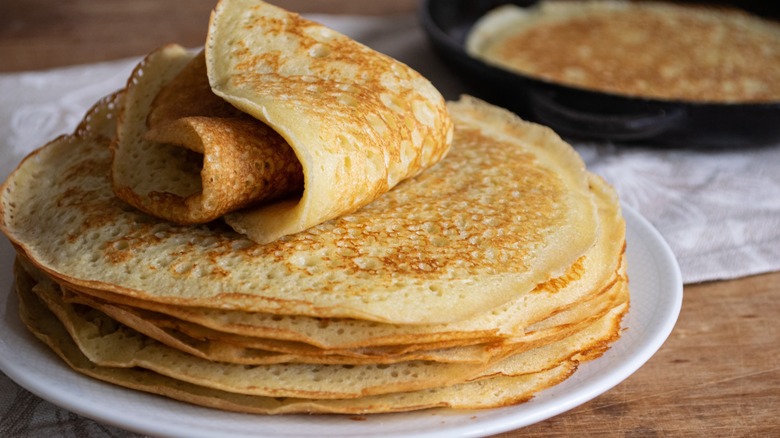Alton Brown's Tip For Crepes That Won't Tear When You Cook Them
Often served with savory additions or sweet fillings, crepes are thin French pancakes traditionally made from a simple batter of flour, milk, eggs, and butter. Notably, crepe recipes lack baking powder, giving the dish its signature flat shape. Crepes are delicious and airy, but above all else, they're difficult to cook. If you've ever attempted to flip one and torn it to shreds in the process, you're not alone. It's one of the most common crepe mistakes you can make — even top-rated chefs like Alton Brown have struggled to perfect the technique.
Dubbed the "crepe killer" in culinary school, Brown found it hard to keep his crepes intact throughout the cooking process, as he describes on his website. For an episode of his Food Network show "Good Eats," however, he was forced to face his crepe-making fears. Ultimately, he writes, the process isn't so bad if you have "the right batter, the right pan, and some patience."
According to his expertise, one simple step can save your crepes from unsightly rips. Before you start turning your batter into crepes, you should leave it in the refrigerator for at least an hour. If possible, try following Brown's lead and allow the batter to rest overnight. Doing so will destroy any bubbles that could potentially make the crepes more fragile. While this may seem like an inconvenience, your crepes will thank you later.
Tips for making the best crepes
Time in the refrigerator is the key to perfect crepe batter. Allowing the dry ingredients to absorb the wet helps the batter develop a thicker consistency, which guarantees more evenly cooked results. As the gluten rests, the mixture also becomes more airy and less cakey, though you may need to mix in a little bit of water afterward to achieve the runny texture necessary for making crepes.
Like Alton Brown, many crepe aficionados have noted the importance of a good pan. From cast iron to non-stick, most pans will do the trick — as long as they're big enough. Generally, 10 inches is the recommended size if you plan to fill or roll your crepes, but any pan that you can comfortably maneuver will do just fine. Swirling the batter as it cooks is also essential for setting your crepes' shape, so make sure you can handle the weight of your chosen vessel.
Timing your flips precisely is also crucial. Your crepe is much more likely to fall apart if you flip it too early, so wait for the right moment when the edges start to brown. Even if you haven't yet mastered the art of flipping, following Brown's advice and letting your batter rest in the fridge will ensure that your next batch of crepes will be more intact than the last.

